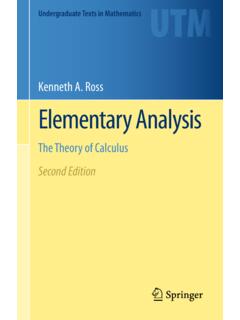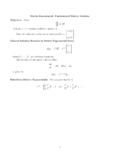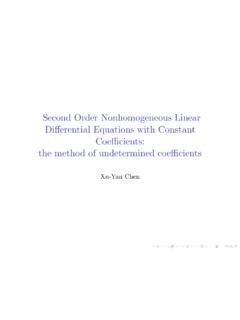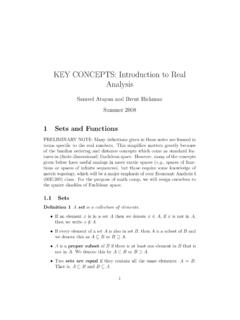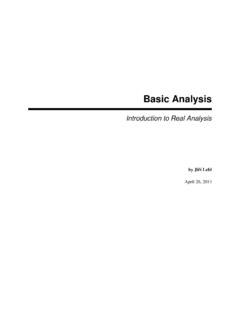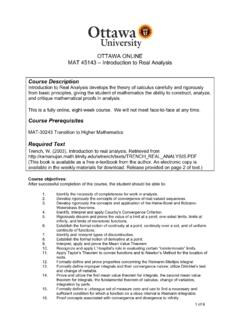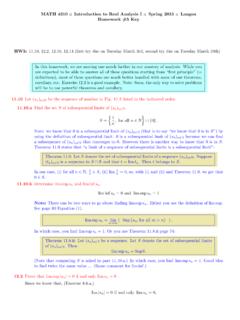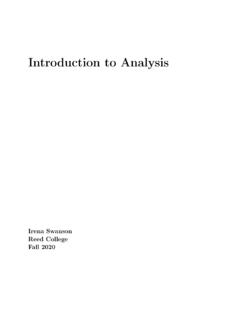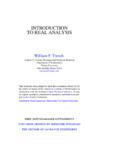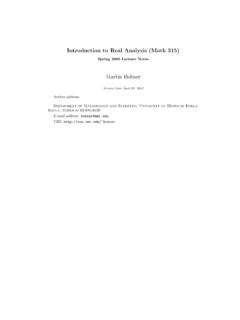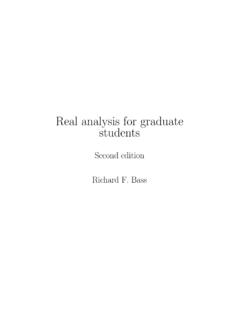Transcription of Introduction to Real Analysis Alternative Chapter 1
1 Christopher HeilIntroduction to real AnalysisAlternative Chapter 1An Introduction to Norms and Banach SpacesLast Updated: April 7, 2019c 2019 by Christopher HeilChapter 1 An Introduction to Norms and online Chapter is an Alternative , expanded version of Chap-ter 1 from the text An Introduction to real Analysis by C. Heil (hereaftercalled the main text ).The main goal of both Chapter 1 and Chapter 1 is to provide a reviewof normed spaces, which appear in various contexts in the main text. Metricspaces also appear in the main text, although more rarely; infact, metricspaces only appear in problems or exercises in the main 1 provides a very brief review of both metric and normed spaces,while this Alternative Chapter provides a much more comprehensive review ofnormed spaces (with metric spaces defined in the exercises).
2 This Chapter 1 gives detailed coverage of the background topics on normed spaces that aremost important for the main text, and it does so with discussion, motivation,and examples (whereas Chapter 1 just gives a brief review of the definitionsand main theorems). Chapter 1 presents many examples that appear in the later chapters of themain text. In particular, the pspaces are introduced and discussed in detailin Chapter 1 , while in the main text they do not appear until Chapter we see an Introduction to theLp-norms in Chapter 1 , althoughthese are not studied in detail until Chapter 7 in the main of what we do in Analysis centers on issues ofconver-genceorapproximation. What does it mean for one object to be close to (orto approximate) another object?
3 How can we define thelimitof a sequence ofobjects that appear to be converging in some sense? If our objects are pointsinRdthen we can simply grab a ruler, embed ourselves intod-dimensionalspace, and measure the physical (orEuclidean) distance between the points are close if the distance between them is small, and a sequenceof pointsxnconverges to a pointxif the distance betweenxnandxshrinksto zero in the limit asn .However, the objects we work with are oftennot points inRdbut instead are elements of some other setX(perhaps a setof sequences, or a set of functions, or some other abstract set). Even so, if12 Alternative Chapter 1c 2019 Christopher Heilwe can find a way to measure the distance between elements ofXthen wecan still think about approximation or convergence.
4 We simply say that twoelements are close if the distance between them is small, anda sequence ofelementsxnconverges to an elementxif the distance fromxntoxshrinksto zero. If thepropertiesof the distance function onXare similar to thoseof Euclidean distance, then we will be able to prove useful theorems aboutXand its elements. We will make these ideas precise in this from the Preliminaries that we let the symbolFdenote achoice of the extended real line [ , ] or the complex , inthis context: ifF= [ , ],then the wordscalarmeans afinite real numberc R; ifF=C,then the wordscalarmeans acomplex numberc , if we say that x= (xk)k Nis a series of scalars, then itis a sequence of real numbers if we have chosenF= [ , ],while it is asequence of complex numbers if we have chosenF= , a scalar-valued functionfonX is a real -valued functionf:X RifF= [ , ],and a complex-valued functionf:X CifF=C.
5 1 .1 The Definition of a NormIn a vector space we can add vectors and multiply vectors by scalars. Anormassigns to each vectorxinXalengthkxkin a way that respects thestructure , a norm must behomogeneousin the sense thatkcxk=|c|kxkfor all scalarscand all vectorsx,and a norm must satisfy theTriangle Inequality, which in this setting takes the formkx+yk kxk+ we have a norm we also have a way of measuring thedistance betweenpoints; the distance betweenxandyislength of their difference, ,kx 1 . (Seminorms and Norms).LetXbe a vector space. AseminormonXis a functionk k:X Rsuch that for all vectorsx, y Xand all scalarscwe have:(a) Nonnegativity: 0 kxk< ,(b) Homogeneity:kcxk=|c|kxk,and(c) The Triangle Inequality:kx+yk kxk+ seminorm is anormif we also have:(d) Uniqueness:kxk= 0 if and only ifx= vector spaceXtogether with a normk kis called anormed vectorspace, anormed linear space, or simply anormed space.
6 1 .1 The Definition of a Norm3We often refer to the elements of a normed spaceXas points or vec-tors, and we mostly use letters such asx, y, zto denote elements of thespace. If the elements of our setXare functions (which is the case for many ofthe examples in this text), then we may refer to them as points, vectors, or functions. Further, if we know that the elements ofXare functions,then we usually denote them by letters such asf, g, h(instead ofx, y, z).We refer to the numberkxkas thelengthof a vectorx,and we say thatkx ykis thedistancebetween the vectorxthat haslength 1 is called aunit vector, or is said to benormalized. Ifyis any nonzerovector, thenx=1kyky=ykykis a unit are some examples of norms 1 . that each of the following is a norm onRd,wherex= (x1.)
7 , xd) denotes a vector inRd.(a) The 1-norm:kxk1=|x1|+ +|xd|.(b) TheEuclidean normor 2-norm:kxk2= |x1|2+ +|xd|2 1/2.(c) The -norm:kxk = max |x1|, .. ,|xd| . The Euclidean norm of a vector inRdis the ordinary physical length ofthe vector (as measured by a ruler ind-dimensional space). The TriangleInequality for the Euclidean norm onR2is illustrated in Figure 1 . 1 .1 The Triangle Inequality for the Euclidean norm vectorsxandyand their sumx+yare pictured. The lengths of the three edges of the triangle drawn withsolid lines arekxk2,kyk2,andkx+yk2,and we can see thatkxk2+kyk2 kx+ Chapter 1c 2019 Christopher Heil1 . The Sequence Space 1 Now we will introduce an infinite-dimensional vector space known as 1 (pronounced little ell one ).
8 The elements of this vector space are infinitesequences of scalars that satisfy a certain summability property, and wewill define a norm on 1that is related to a sequence of scalarsx= (xk)k N= (x1, x2, ..),we define the 1-norm ofxto bekxk1=k(xk)k Nk1= Xk=1|xk|.(1 .1)In some sense, the quantitykxk1measures the size size is finitefor some sequences but infinite for others. For example, ifx= (1,1,1, ..)thenkxk1= ,but for the sequencey= (1,14,19, ..) we have (byEuler sFormula) thatkyk1=P k=11k2= 26< .We say that a sequencex= (xk)k Nisabsolutely summable, or justsummablefor short, ifkxk1< .We let 1denote the space of all summablesequences, , 1= x= (xk)k N:kxk1= Xk=1|xk|< .That is, 1contains exactly those sequencesx= (xk)k Nfor are some examples (the reader should verify these, and constructother examples of sequences that do or do not belong to 1).
9 X= (1,1,1, ..)/ 1; y= 1k2 k N= (1,14,19,116, ..) 1; s= (1,0, 1,0,0,1,0,0,0, 1, ,0,0,0,0,1, ..)/ 1; t= ( 1,0,12,0,0, 13,0,0,0,14,0,0,0,0, 15, ..)/ 1; ifp >1,thenu= ( 1)kkp k N 1; v= (2 k)k N= 12,14,18, .. 1; ifzis a scalar with absolute value|z|<1,thenw= zk k N that a sequencex= (xk)k Nbelongs to 1if and only if the sequenceof absolute valuesy= (|xk|)k Nbelongs to (x1, x2, ..) andy= (y1, y2, ..) are two elements of 1,thenx+y= (xk+yk)k N= (x1+y1, x2+y2, ..)1 .1 The Definition of a Norm5also belongs to 1(why?). Likewise, ifcis scalar thencx= (cx1, cx2, ..)is an element of 1is closed under addition of vectors and underscalar multiplication, and the reader should verify that itfollows from thisthat 1is a vector space. Therefore we often call a sequencex= (xk)k Nin 1a vector.
10 Althoughxis a sequence of infinitely many numbersxk,it isjust one element of 1,and so we also often say thatxis one point in 1 . quantitykxk1is defined for every sequencex,althoughit could be .For example, ifx= (1,1,1, ..) thenkxk1= ,while ifx= (12,14,18, ..) thenkxk1= space 1consists of all thosexforwhichkxk1is finite. In this example, it is not thatkxk1does not exist whenx / 1,but rather that it is not finite whenx / need not be the casein other circumstances. Ifk kis a norm on a vector spacex,thenkxkneedonly be defined for vectors inx; it could simply be undefined (rather thanbeing infinite) for vectors not inX. Lemma 1 . k1is a norm on nonnegativity and finiteness condition 0 kxk1< is certainlysatisfied for eachx 1,and the homogeneity condition is Triangle Inequality follows from the calculationkx+yk1= Xk=1|xk+yk| Xk=1 |xk|+|yk| = Xk=1|xk|+ Xk=1|yk|=kxk1+ , ifkxk1= 0 then we must havexk= 0 for everyk,sox= (0,0.)
